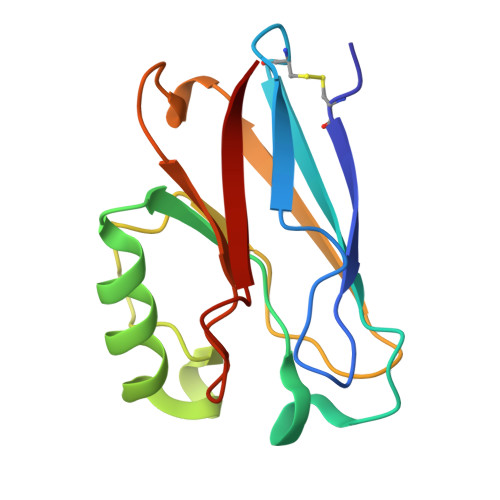Beyond Blue: Systematic Modulation of Electronic Structure and Redox Properties of Type 1 Copper in Azurin.
Van Stappen, C., Xu, J., Liu, Y., Van Stappen, J., Kim, W., Zhang, Y.J., Lu, Y.(2025) J Am Chem Soc 147: 24825-24837
- PubMed: 40626760
- DOI: https://doi.org/10.1021/jacs.5c07009
- Primary Citation of Related Structures:
9OH6, 9OH7 - PubMed Abstract:
The reduction potentials of metal ions ( E °'), crucial for optimizing biological processes like electron transfer and catalysis, are finely tuned by interactions between the primary and secondary coordination spheres (PCS, SCS). While previous successes in tuning E °' in azurin have provided deeper insights into how the SCS influences electronic structure and associated redox properties of "classic" blue copper proteins, our understanding of E °' tuning in other subclasses of type 1 Cu (T1Cu) proteins, such as green and red copper proteins, remains rudimentary. To address this issue, we report the design of a green copper center in azurin where an equatorial-to-axial shift in a histidine binding interaction leads to reorientation of the Cu-centered redox active molecular orbital and a +100 mV shift in E °'. In contrast to a 22 mV decrease in E °' when a hydrophobic interaction is introduced in wild-type azurin through the Met13Phe mutation, this same mutation leads to a 65 mV increase in our designed green Cu azurin. More importantly, using a combination of EPR spectroscopy, protein crystallography, and quantum mechanical calculations, we uncover correlations between E °', d-s orbital mixing, and the angle between S Cys -Cu and N δH46 -Cu bonds, ∠(S Cys -Cu-N δH46 ), allowing rationalization of increases in E °' of green Cu proteins through an entropically driven T-shape distortion. By providing direct connections between geometry, electronic structure, and functional properties such as E °', this work opens previously unexplored routes to systematically modulating E °' through the combination of spatial reorientation of the redox active molecular orbital and varying geometric distortion in the primary coordination sphere.
Organizational Affiliation:
Department of Chemistry, University of Texas at Austin, 105 E. 24th Street, Austin, Texas 78712, United States.


















